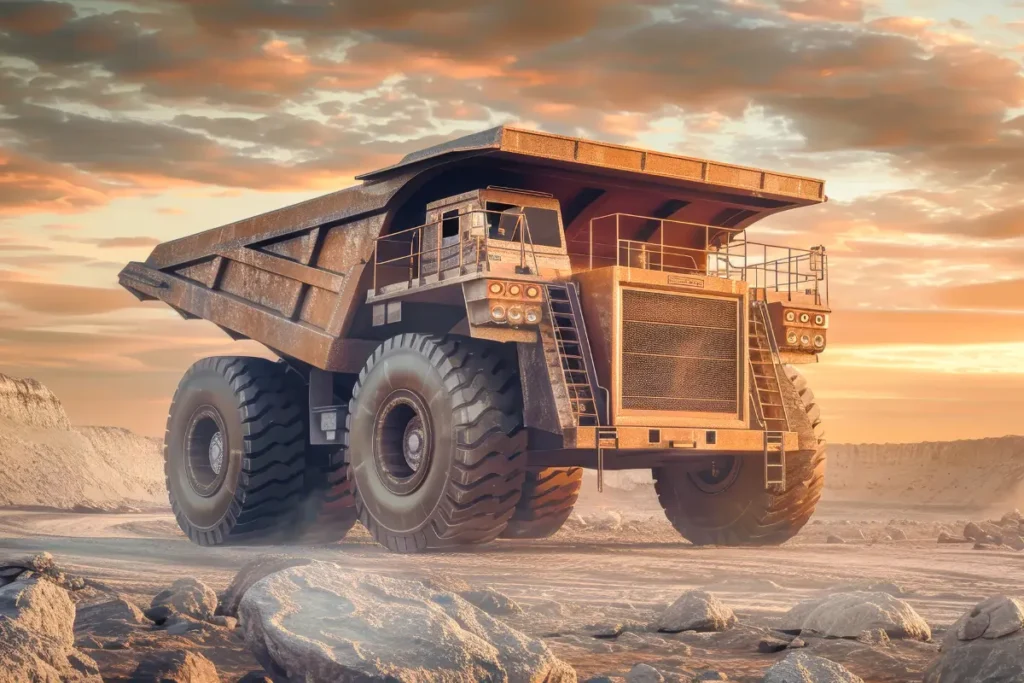
New trends are reshaping how vocational transportation and industrial services businesses will operate in 2025. From technological advancements to sustainability, understanding current trends and how they impact our industries is crucial to staying competitive. These are the top anticipated trends in 2025 and how they will impact your business and financing for heavy equipment.
Table of Contents
Sustainability takes center stage in construction
Growing sustainability is a trend that’s here to stay. It’s driven by regulatory pressures, consumer demands, and a response to global climate change pressures. Here’s a look at what’s impacting construction businesses.
- Energy-efficient designs: Governments worldwide are tightening building codes, requiring developers to design buildings that use less energy. Energy-efficient designs focus on reducing the heating, cooling, and electrical load of every building. Passive solar design, for example, leverages natural sunlight to reduce reliance on artificial lighting and heat. Expect more projects incorporating green roofs, advanced insulation materials, and high-performance windows to minimize energy loss.
- Sustainable materials: The construction sector accounts for significant global CO2 emissions, mainly from traditional materials like concrete and steel. In 2025 there will be a stronger push toward sustainable building materials such as bamboo, cross-laminated timber (CLT), recycled steel, and novel concrete materials. In some applications, CLT can replace concrete and steel, offering lower carbon emissions and faster construction times.
- Circular economy in construction: Instead of the traditional linear construction models, where materials are used once and discarded, more companies are adopting recycling and reuse practices. Using recycled materials answers a call for waste reduction. Some construction companies are already experimenting with using recycled concrete and salvaged steel.
- Carbon-neutral or carbon-negative practices: Projects will offset carbon emissions through renewable energy integration, carbon capture technologies, and bio-based materials are on the horizon. Leading firms will adopt carbon accounting tools that help measure and reduce the carbon footprint of their construction operations.
Digital transformation and the rise of AI
The construction industry isn’t exempt from advances in technology. Digital transformation will continue revolutionizing how buildings are designed, constructed, and managed. For 2025, artificial intelligence (AI), machine learning (ML), and the Internet of Things (IoT) will be front and center – changes equipment finance industry leaders are planning to carefully implement, and which are on the horizon for construction customers.
- Building Information Modeling (BIM): BIM technology is already widely used in construction, but its capabilities continue to advance. With the integration of AI, 5D BIM will not only visualize structures in 3D but also factor in time and cost, leading to more precise project planning and execution. AI will allow BIM systems to adjust schedules or resource allocations based on real-time data. Having the most up-to-date data has the potential to significantly reduce delays and cost overruns.
- Predictive analytics with AI: AI and machine learning will enable construction companies to use predictive analytics, essential for making informed decisions. For example, AI can analyze large datasets from past projects and current site conditions to predict potential risks. Those could include project delays, equipment failures, or safety hazards. With these carefully vetted insights, your construction business can proactively address issues before they escalate, improving efficiency and safety.
- IoT-enabled equipment: Smart sensors embedded in machinery will update the equipment’s performance, location, and maintenance needs. Your business can optimize fleet management because these sensors allow operators to monitor machine health remotely, ensuring timely repairs and preventing costly breakdowns.
Modular and prefabrication expansion
Modular and prefabricated construction is rapidly becoming a construction industry staple due to its numerous advantages. In 2025, this method of building will be far more widespread across commercial, residential, and industrial projects.
- Reduced construction time: Modular construction allows simultaneous off-site manufacturing of building components while the foundation is prepared on-site. This parallel construction process can reduce building times, sometimes by almost half. Shortened project timelines are particularly beneficial for large-scale projects with tight deadlines.
- Cost savings: Economies of scale are possible with modular construction because of the mass production of standardized components. The ability to produce parts in this way reduces material waste and labor costs, making it an appealing option for developers looking to cut project expenses. In 2025, modular construction will likely be the go-to method for affordable housing projects in urban areas.
- Design flexibility: Prefabricated modules are now customizable and meet the unique needs of each project without sacrificing the benefits of on-site building.
Smart infrastructure
Smart cities are becoming a reality. Urban infrastructure integrated with advanced technologies are promoted to improve efficiency, sustainability, and quality of life.
- Intelligent traffic management: AI-powered traffic management systems will benefit congested urban areas. These systems will use IoT sensors, cameras, and GPS data to optimize traffic flow, reduce congestion, and lower vehicle emissions due to traffic. By dynamically adjusting traffic signals and rerouting vehicles based on real-time data, smart cities are designed to minimize bottlenecks, saving time and fuel.
- Smart utilities: Cities are upgrading energy grids with technology that monitors and manages water, electricity, and waste management. For example, smart grids can use AI to predict peak electricity usage and distribute energy selectively, reducing waste and lowering utility costs.
- Sustainable urban planning: Urban planners increasingly rely on data-driven insights as cities grow. Sensors embedded in roads, buildings, and public spaces collect data, enabling planners to make informed decisions about zoning, transportation, and green spaces.
System automation
Robotics and automation are already transforming industries, but in 2025, their impact will be far-reaching across construction, vocational transportation, and industrial services.
- Autonomous construction equipment: Self-driving construction vehicles will become more common in 2025, in an effort to address labor shortages and improve safety. Autonomous excavators, bulldozers, and dump trucks will handle repetitive tasks such as earthmoving, grading, and hauling materials. These machines can operate at all hours, accelerating project timelines.
- Drones: Drones will continue to play a significant role in site inspections, mapping, and surveying. Equipped with advanced cameras and AI, drones can capture high-resolution images and generate 3D models of construction sites. These models could reduce project delays and costs by helping project managers identify potential issues early, avoiding the need for rework.
Vocational transportation trends
Vocational transportation is critical to many industries. This sector is expected to experience significant changes due to electric vehicle regulations, telematics, and autonomous driving technology.
- Electric vehicles (EVs): The transition to electric vocational vehicles will gain momentum in 2025 as environmental regulations tighten and fuel costs rise. Electric trucks and vocational vehicles reduce emissions and will purportedly lower operating costs. Proponents say electric motors require less upkeep than traditional internal combustion engines. With the development of fast-charging infrastructure, electric trucks will become more practical for longer delivery and hauling routes.
- Autonomous trucking: Self-driving trucks are becoming a reality, particularly in controlled environments. Autonomous vehicles can operate continuously, reducing delivery times and improving efficiency. However, widespread adoption may take time due to regulatory hurdles and safety concerns.
- Fleet telematics: Telematics systems provide real-time data on vehicle performance, driver behavior, and route optimization. Companies like UPS and FedEx already use telematics to optimize delivery routes, in an effort to save fuel and reduce emissions.
Industrial services trends
Industrial service sectors are facing significant transitions as the world moves toward cleaner energy. In 2025, companies will face pressure to balance their traditional operations with the growing demand for renewables.
- Renewable integration: While oil and gas will still be essential, industrial services companies will increasingly add renewable energy sources into oilfield operations. Increased renewable integration will be focused on reducing operational costs and helping industrial companies meet changing environmental regulations.
- Digital oil fields: Virtual replicas of physical oil fields allow operators to monitor conditions remotely, making real-time adjustments to optimize production and reduce downtime. Oilfield and energy industrial companies are already beginning to use drone technology to inspect pipelines, while AI-powered predictive maintenance is tasked with ensuring equipment operates efficiently.
Carbon Capture and Storage (CCS): Oil companies will continue to invest in carbon capture and storage technologies to reduce their carbon footprint. These systems capture CO2 emissions from drilling and refining operations and store them underground, preventing them from entering the atmosphere.
Dealer financing for heavy equipment in 2025 and beyond
Many businesses are planning ahead for changes to business practices in the areas of sustainability, digital transformation, and automation. Equipment fleet managers are exploring ways to upgrade equipment as business requirements change.
As equipment in construction, vocational transportation, and industrial services becomes more expensive and complex, structured finance solutions will face their own evolution. In 2025, financing for heavy equipment will focus on flexibility, digital transformation, and sustainability.
- Online financing platforms: Online platforms are streamlining the equipment financing process. Many applications start online. Accessing applications online makes it easier to apply for loans, compare options, and receive approvals.
- Flexible financing structures: Seasonal payment plans, deferred payments, and lease options are becoming more common in heavy equipment financing. Flexible financing options allow you to align your financing obligations with your cash flow patterns. Customization and flexibility are essential for industries with seasonal peaks, such as agriculture and construction, where income fluctuates throughout the year.
If your business is exploring new and better financing for heavy equipment options that leverage equipment equity to improve cash flow and reduce payments, connect with your local structured finance rep to start a conversation. Together with Equify Financial’s dedicated team of industry equipment experts, we’ll help you create a path forward for your fleet – and your business – to meet changing priorities in 2025 and beyond.
